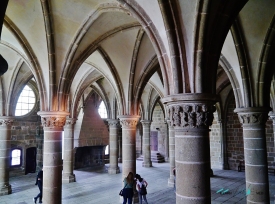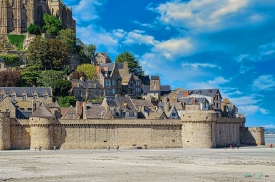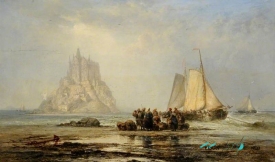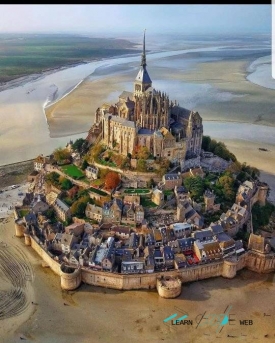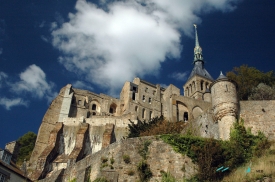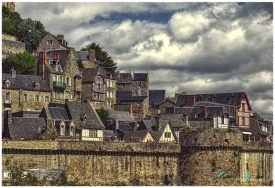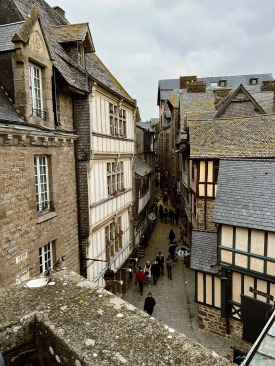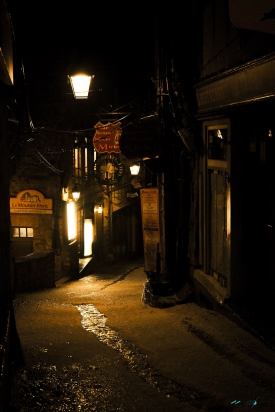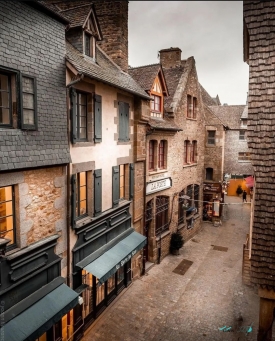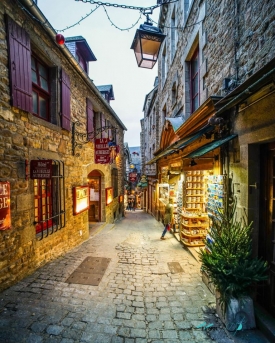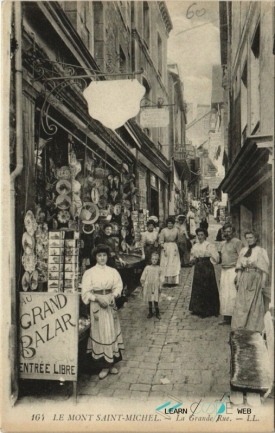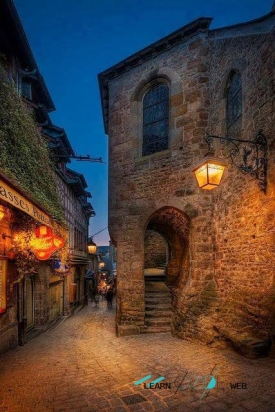The abbey is classified as a historical monument by the list of 1862, which rescues the main historical monuments of France.
The site is inscribed twice on the UNESCO World Heritage List: once in 1979 under the title of "Mont Saint-Michel and its bay" and a second time in 1998 as part of the "Ways of Compostela in France". ". It is owned by the French State, being managed by the Center des Monuments Nationaux.
The architecture of Mont-Saint-Michel and its bay make it the busiest tourist site in Normandy and one of the ten most visited in France with nearly two and a half million visitors each year.
A statue of Saint Michael placed on top of the abbey church rises 157.10 meters above the shore.
In 2019, the city had 29 inhabitants, called Montois. The islet of Mont Saint-Michel has become over time an emblematic element of French heritage.
With the advent of Christianity in the region, around the 4th century, Mont Tombe became part of the diocese of Avranches, whose limits correspond to the former territory of the Abrincates. In the middle of the 6th century, Christianity really took root in the bay. The hermits Saint Pair and Saint Scubilion founded a chapel dedicated to the first Christian martyr, Saint Etienne, raised halfway up the rock, and a second in honor of the first martyr of Autun, Saint Symphorien, raised at the foot of the rock.
In 1960, Yves-Marie Froidevaux, chief architect of historical monuments, found a cyclopean wall to the east of the Notre-Dame-Sous-Terre chapel that could constitute the remains of the oratory built in 708 by Saint Aubert. This sanctuary would be a reliquary chapel that would house the tomb of the founder, Aubert, and the flagship relics brought from Mont-Gargan or invented (stone with the imprint, cape, shield, sword, disappeared during the Revolution). The chapel, therefore, would have replaced the primitive oratory.
The first constructions were insufficient and in the Carolingian period important buildings were erected around which the individual cells of the monks were distributed. Throughout the Middle Ages, it was commonly nicknamed Mons Sancti Michaeli in periculo maris by clerics before the name "Mont-Saint-Michel" gradually took hold.
When Richard I "without fear", son of Guillaume Longue-Épée, succeeded him as Duke of Normandy, he took the resolution, after the approval of Pope John XIII and King Lothair, to replace the collegiate church du Mont with a monastery ( a monastery) when Benedictines installed themselves in place of the canons of Saint Aubert, as mentioned in the Introductio monachorum ("the installation of the monks"), a treatise composed around 1080-1095 by a monk from Mont-Saint-Michel seeking defend the thesis of the independence of the monastery with respect to temporal power.
Between the year 1009 and around 1020, the land between Sélune and Couesnon was conquered from the Bretons, definitively turning Mont Saint-Michel into a Norman island. These conflicts did not prevent the dukes of Brittany Conan le Tort, who died in 992, and Geoffrey I, who died in 1008, from being buried, as benefactors, at Mont-Saint-Michel.
This conquest by the Norman sovereigns will be decisive for the future of the abbey. The new lords of Normandy, therefore, are willing to give tokens to the Church to show that they have become good Christians, an essential element both in their relationship with their populations and with those of the French crown. The financing of monasteries and churches, and in particular the abbey of Mont Saint Michel, therefore offers a perfect opportunity to redeem its image and show itself as a defender and promoter of the Christian religion in its territory. The growth of the Mount under Norman sovereignty will therefore be the result of very political issues.
In the first half of the 12th century, the Benedictines of Mont-Saint-Michel would have had, according to various historians, a great influence on the intellectual development of Europe by translating Aristotle directly from ancient Greek into Latin; the oldest of the manuscripts of Aristotle's works, in particular the Categories, date from the tenth and eleventh centuries, that is, before other translations were made in Toledo from Arabic, or in Italy.
In 1204, the King of France, Philip II, having crossed the Normandy border with an army, his ally, Guy de Thouars, the new Bailister duke of Brittany, attacked Avranchin at the head of a Breton army. Mont-Saint-Michel was the first point towards which Guy de Thouars' efforts were directed before recovering Avranchin and Cotentin. After long and futile efforts, Guy de Thouars, desperate to gain control of the abbey, whose fortifications withstood the Breton attacks, withdrew, leaving the city to burn. The city was sacked and the people of Mons massacred, regardless of their age or gender. The disaster developed with such violence that the flames, rushing to the top of the mountain, overflowed onto the abbey, reducing almost all the buildings to ashes.
Felipe II felt the greatest pain for this disaster and, wanting to erase the traces of this misfortune, he sent the Abbé Jordan a large sum of money destined to repair these ravages. It was Abbots Jourdain and Richard Tustin who surrounded the abbey with a first fortified enclosure. Remnants of these works remain: the Belle Chaise, Corbins's octagonal tower at the end of Merveille, and the northern ramparts, above the abbey forest. From the same period are the Fanils tower, the Pilette watchtower and to the west the walls that surround the access ramp that serves as the second entrance to Mont.
Rebuilt in the Norman architectural style, with abacuses with circular capitals, spandrels in Caen stone, plant motifs, etc., the cloister of La Merveille was completed in 1228.
In 1386, Pierre Le Roy was elected abbot and ordered the construction of the Perrine tower, the battlemented barbican with double access closed by tilting leaves, the Grand Degré and the Claudine tower that watches over it, and the Châtelet. After the battle of Agincourt, the new abbot, Robert Jollivet, had a wall built from 1417 to protect the town, as well as a large cistern hewn "in living rock" behind the apse of the abbey in 1418 to supply the Mount with fresh water.
In 1419, Rouen fell to the English. Charles VII appointed Jean VIII d'Harcourt captain of the Mount to face the risk of an English invasion. The Mount was then the only site in Normandy still holding out against the English who besieged it between 1423 and 1440, established a blockade by land and sea and built two bastilles at Tombelaine and Ardevon.
Jean d'Harcourt was killed at the Battle of Verneuil in August 1424 and was succeeded by Jean de Dunois. The monks of the Mount reinforced its defenses with their own funds, collecting some of their religious silverware to be melted down in the money workshop installed on the Mount by the king since 1420. The English reinforced Tombelaine. Louis d'Estouteville replaced Jean on September 2, 1424, and the latter withdrew from the city, on November 17, 1424, the women, children and old men.
In 1433, when a fire destroyed part of the town, the English used the opportunity to attack the abbey. Thomas de Scales launched on June 17, 1434, at high and low tide, with artillery and war machines, a major offensive on Mt. During the long 30-year siege, the fortress abbey was only permanently defended by about twenty people, the 1434 assault included no more than 2,000 English. This last attack by the English, during which the army of Thomas Scalles surrendered to the bombardment attacks (two of these artillery pieces, the famous "Michelettes", are visible at the entrance to Mont-Saint-Michel), after which they contented themselves with watching them from Tombelaine and its bastilles. Since then,
A national symbol of resistance against the English, the abbey's prestige has, however, declined since the 12th century, losing its military and religious interest (the system of encomienda instituted in 1523 by the king of France ended up ruining the abbey), although the kings they keep coming on pilgrimage to Mt. During the Wars of Religion the Huguenots try to seize this stronghold from the Catholic League in 1577, 1589, 1591. Under the Old Regime, the mount becomes a place of detention for various people imprisoned under different jurisdictions: legends claim that the Abbots established dungeons as early as the 11th century. There is evidence of a state prison under Louis XI who had a girl installed in the Romanesque abbey house, a cage of wood and iron suspended under a vault.
The relaxation of customs (some monks live with wives and children) despite the 1622 reform by the Maurists and the lack of maintenance caused Louis XV, in 1731, to transform part of the abbey into a state prison. It earned its nickname "bastille of the seas" where Victor Dubourg de La Cassagne or Desforges were imprisoned. In 1766, the fortress abbey fell into ruin. At the end of the 18th century, the abbey housed only about ten monks. Paradoxically, this prison use saved this great testimony of religious architecture because many abbeys that became national property in 1789 were razed to the ground, sold to private individuals, turned into quarries or ruined due to lack of maintenance.
The site is inscribed twice on the UNESCO World Heritage List: once in 1979 under the title of "Mont Saint-Michel and its bay" and a second time in 1998 as part of the "Ways of Compostela in France". ". It is owned by the French State, being managed by the Center des Monuments Nationaux.
The architecture of Mont-Saint-Michel and its bay make it the busiest tourist site in Normandy and one of the ten most visited in France with nearly two and a half million visitors each year.
A statue of Saint Michael placed on top of the abbey church rises 157.10 meters above the shore.
In 2019, the city had 29 inhabitants, called Montois. The islet of Mont Saint-Michel has become over time an emblematic element of French heritage.
With the advent of Christianity in the region, around the 4th century, Mont Tombe became part of the diocese of Avranches, whose limits correspond to the former territory of the Abrincates. In the middle of the 6th century, Christianity really took root in the bay. The hermits Saint Pair and Saint Scubilion founded a chapel dedicated to the first Christian martyr, Saint Etienne, raised halfway up the rock, and a second in honor of the first martyr of Autun, Saint Symphorien, raised at the foot of the rock.
In 1960, Yves-Marie Froidevaux, chief architect of historical monuments, found a cyclopean wall to the east of the Notre-Dame-Sous-Terre chapel that could constitute the remains of the oratory built in 708 by Saint Aubert. This sanctuary would be a reliquary chapel that would house the tomb of the founder, Aubert, and the flagship relics brought from Mont-Gargan or invented (stone with the imprint, cape, shield, sword, disappeared during the Revolution). The chapel, therefore, would have replaced the primitive oratory.
The first constructions were insufficient and in the Carolingian period important buildings were erected around which the individual cells of the monks were distributed. Throughout the Middle Ages, it was commonly nicknamed Mons Sancti Michaeli in periculo maris by clerics before the name "Mont-Saint-Michel" gradually took hold.
When Richard I "without fear", son of Guillaume Longue-Épée, succeeded him as Duke of Normandy, he took the resolution, after the approval of Pope John XIII and King Lothair, to replace the collegiate church du Mont with a monastery ( a monastery) when Benedictines installed themselves in place of the canons of Saint Aubert, as mentioned in the Introductio monachorum ("the installation of the monks"), a treatise composed around 1080-1095 by a monk from Mont-Saint-Michel seeking defend the thesis of the independence of the monastery with respect to temporal power.
Between the year 1009 and around 1020, the land between Sélune and Couesnon was conquered from the Bretons, definitively turning Mont Saint-Michel into a Norman island. These conflicts did not prevent the dukes of Brittany Conan le Tort, who died in 992, and Geoffrey I, who died in 1008, from being buried, as benefactors, at Mont-Saint-Michel.
This conquest by the Norman sovereigns will be decisive for the future of the abbey. The new lords of Normandy, therefore, are willing to give tokens to the Church to show that they have become good Christians, an essential element both in their relationship with their populations and with those of the French crown. The financing of monasteries and churches, and in particular the abbey of Mont Saint Michel, therefore offers a perfect opportunity to redeem its image and show itself as a defender and promoter of the Christian religion in its territory. The growth of the Mount under Norman sovereignty will therefore be the result of very political issues.
In the first half of the 12th century, the Benedictines of Mont-Saint-Michel would have had, according to various historians, a great influence on the intellectual development of Europe by translating Aristotle directly from ancient Greek into Latin; the oldest of the manuscripts of Aristotle's works, in particular the Categories, date from the tenth and eleventh centuries, that is, before other translations were made in Toledo from Arabic, or in Italy.
In 1204, the King of France, Philip II, having crossed the Normandy border with an army, his ally, Guy de Thouars, the new Bailister duke of Brittany, attacked Avranchin at the head of a Breton army. Mont-Saint-Michel was the first point towards which Guy de Thouars' efforts were directed before recovering Avranchin and Cotentin. After long and futile efforts, Guy de Thouars, desperate to gain control of the abbey, whose fortifications withstood the Breton attacks, withdrew, leaving the city to burn. The city was sacked and the people of Mons massacred, regardless of their age or gender. The disaster developed with such violence that the flames, rushing to the top of the mountain, overflowed onto the abbey, reducing almost all the buildings to ashes.
Felipe II felt the greatest pain for this disaster and, wanting to erase the traces of this misfortune, he sent the Abbé Jordan a large sum of money destined to repair these ravages. It was Abbots Jourdain and Richard Tustin who surrounded the abbey with a first fortified enclosure. Remnants of these works remain: the Belle Chaise, Corbins's octagonal tower at the end of Merveille, and the northern ramparts, above the abbey forest. From the same period are the Fanils tower, the Pilette watchtower and to the west the walls that surround the access ramp that serves as the second entrance to Mont.
Rebuilt in the Norman architectural style, with abacuses with circular capitals, spandrels in Caen stone, plant motifs, etc., the cloister of La Merveille was completed in 1228.
In 1386, Pierre Le Roy was elected abbot and ordered the construction of the Perrine tower, the battlemented barbican with double access closed by tilting leaves, the Grand Degré and the Claudine tower that watches over it, and the Châtelet. After the battle of Agincourt, the new abbot, Robert Jollivet, had a wall built from 1417 to protect the town, as well as a large cistern hewn "in living rock" behind the apse of the abbey in 1418 to supply the Mount with fresh water.
In 1419, Rouen fell to the English. Charles VII appointed Jean VIII d'Harcourt captain of the Mount to face the risk of an English invasion. The Mount was then the only site in Normandy still holding out against the English who besieged it between 1423 and 1440, established a blockade by land and sea and built two bastilles at Tombelaine and Ardevon.
Jean d'Harcourt was killed at the Battle of Verneuil in August 1424 and was succeeded by Jean de Dunois. The monks of the Mount reinforced its defenses with their own funds, collecting some of their religious silverware to be melted down in the money workshop installed on the Mount by the king since 1420. The English reinforced Tombelaine. Louis d'Estouteville replaced Jean on September 2, 1424, and the latter withdrew from the city, on November 17, 1424, the women, children and old men.
In 1433, when a fire destroyed part of the town, the English used the opportunity to attack the abbey. Thomas de Scales launched on June 17, 1434, at high and low tide, with artillery and war machines, a major offensive on Mt. During the long 30-year siege, the fortress abbey was only permanently defended by about twenty people, the 1434 assault included no more than 2,000 English. This last attack by the English, during which the army of Thomas Scalles surrendered to the bombardment attacks (two of these artillery pieces, the famous "Michelettes", are visible at the entrance to Mont-Saint-Michel), after which they contented themselves with watching them from Tombelaine and its bastilles. Since then,
A national symbol of resistance against the English, the abbey's prestige has, however, declined since the 12th century, losing its military and religious interest (the system of encomienda instituted in 1523 by the king of France ended up ruining the abbey), although the kings they keep coming on pilgrimage to Mt. During the Wars of Religion the Huguenots try to seize this stronghold from the Catholic League in 1577, 1589, 1591. Under the Old Regime, the mount becomes a place of detention for various people imprisoned under different jurisdictions: legends claim that the Abbots established dungeons as early as the 11th century. There is evidence of a state prison under Louis XI who had a girl installed in the Romanesque abbey house, a cage of wood and iron suspended under a vault.
The relaxation of customs (some monks live with wives and children) despite the 1622 reform by the Maurists and the lack of maintenance caused Louis XV, in 1731, to transform part of the abbey into a state prison. It earned its nickname "bastille of the seas" where Victor Dubourg de La Cassagne or Desforges were imprisoned. In 1766, the fortress abbey fell into ruin. At the end of the 18th century, the abbey housed only about ten monks. Paradoxically, this prison use saved this great testimony of religious architecture because many abbeys that became national property in 1789 were razed to the ground, sold to private individuals, turned into quarries or ruined due to lack of maintenance.



